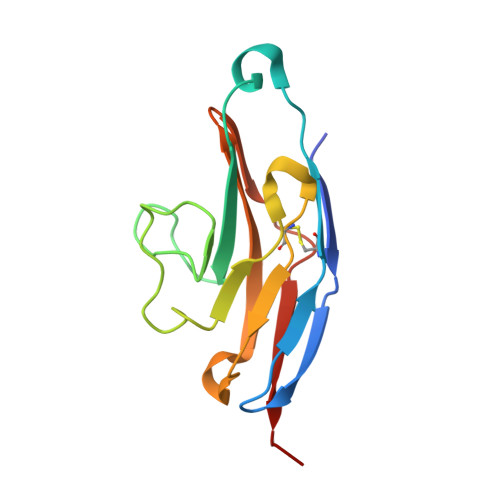Small Molecule Binding to Alzheimer Risk Factor CD33 Promotes A beta Phagocytosis.
Miles, L.A., Hermans, S.J., Crespi, G.A.N., Gooi, J.H., Doughty, L., Nero, T.L., Markulic, J., Ebneth, A., Wroblowski, B., Oehlrich, D., Trabanco, A.A., Rives, M.L., Royaux, I., Hancock, N.C., Parker, M.W.(2019) iScience 19: 110-118
- PubMed: 31369984
- DOI: https://doi.org/10.1016/j.isci.2019.07.023
- Primary Citation of Related Structures:
6D48, 6D49, 6D4A - PubMed Abstract:
Polymorphism in the microglial receptor CD33 gene has been linked to late-onset Alzheimer disease (AD), and reduced expression of the CD33 sialic acid-binding domain confers protection. Thus, CD33 inhibition might be an effective therapy against disease progression. Progress toward discovery of selective CD33 inhibitors has been hampered by the absence of an atomic resolution structure. We report here the crystal structures of CD33 alone and bound to a subtype-selective sialic acid mimetic called P22 and use them to identify key binding residues by site-directed mutagenesis and binding assays to reveal the molecular basis for its selectivity toward sialylated glycoproteins and glycolipids. We show that P22, when presented on microparticles, increases uptake of the toxic AD peptide, amyloid-β (Aβ), into microglial cells. Thus, the sialic acid-binding site on CD33 is a promising pharmacophore for developing therapeutics that promote clearance of the Aβ peptide that is thought to cause AD.
Organizational Affiliation:
ACRF Rational Drug Discovery Centre, St. Vincent's Institute of Medical Research, Fitzroy, VIC 3056, Australia; Department of Biochemistry and Molecular Biology, Bio21 Molecular Science and Biotechnology Institute, University of Melbourne, Parkville, VIC 3010, Australia. Electronic address: lmiles@svi.edu.au.
















